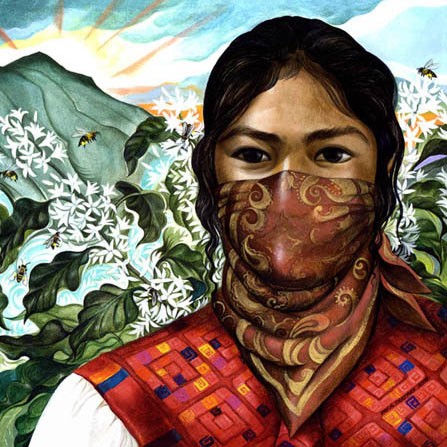Gilberto López y Rivas
Originally published in Spanish in La Jornada
One of the features of the current 4T[1]government is that it doesn’t listen to, let alone, deal with the serious reports around the reemergence of paramilitary groups in Chiapas, like those that make up the Regional Organization of Coffee Growers in Ocosingo (Orcao), that on August 22 looted and burned the facilities of the Nuevo Amanecer del Arcoiris (New Dawn of the Rainbow) marketplace in the autonomous zone Lucio Cabañas (Ocosingo). Joining the provocation were various groups that have also been recognized since the 90s as paramilitary groups, such as “Peace and Justice” and “The Chinchulines” who have once again committed all types of attacks in various regions in Chiapas, in particular in the towns of Tila and Aldama. In recent weeks, statements of support for the EZLN have been shared across various networks and local and national media outlets, including one statement “Stop the War Against the Zapatistas” which has been signed by hundreds of organizations, academics, artists, and solidarity networks from 22 different countries (https://alto-a-la-guerra-contra -lxs-zapatistas.webnode.mx/).
The attack on August 22 against the Zapatista support bases is part of a continued counterinsurgency strategy that previous governments have carried out against the Zapatistas, and which the Grupo de Acción Comunitaria (Community Action Group) and the Miguel Agustín Pro Juárez Center for Human Rights have for two decades now described as a “war of exhaustion,” developed in the American counterinsurgency manuals as a series of small operations that stifle the “enemy” on political, economic, and military grounds, avoiding, if possible, dramatic actions that draw the attention of the press and international public eye. (Ahora apuestan al cansancio. Chiapas: fundamentos sicológicos de una guerra contemporánea, 2002).In this type of war, the role that paramilitary groups play is fundamental. According to one of the irregular warfare manuals of the Sedena, it doesn’t just have to do with “draining the water to kill the fish” (the water being the support bases of the rebellion), but rather, adding “more ferocious fish” to the water. These are the paramilitary groups that have been organized, armed, and trained by the army and to whom the State delegates those missions that the regular armed forces can’t openly carry out, an arrangement that doesn’t necessitate their recognition as part of the monopoly of state violence. The paramilitary groups are simultaneously illegal and have impunity because this arrangement suits the interests of the State. The paramilitary consists, then, of an illegal exercise of the violence of the State with impunity, and the concealment of the origins of that violence. Just like in previous openly neoliberal and counterinsurgent administrations, the 4T government continues the so-called “theatre of war.” Zósimo Camacho argues that today the largest number of military personnel are located in Chiapas and act, to use a metaphor, as the anvil that lays siege to the area in conflict via encampments, troops, convoys, intelligence agents, air and ground surveillance, etc.. The paramilitary groups, following the metaphor, are “the hammer” that strikes the people with actions like those of August 22nd, in order to incite terror, create the conditions for the expulsion and displacement of indigenous communities, and ally with civil, military, and police authorities to find the “internal enemy” that refuses to follow the logic of capital, all under the guise of “progress, development” and (precarious) employment.
Together with the actions of paramilitary groups, a media campaign against the Zapatistas has been intensifying on social media and in the news with outrageous lies, including that the EZLN territory is controlled by a drug cartel that provides them with high-caliber weapons, a claim that has been rigorously analyzed and refuted in depth by Luis Hernández Navarro in an interview with Ernesto Ledezma Arronte on Rompeviento TV. (https://wwwyoutube.com/ watch?v=gdDNI9m_8).
Regrettably, and in unison with this campaign, the head of the executive branch made an unfortunate and concerning pronouncement in his morning conference on August 28, in which he tried to stigmatize and criminalize the work of human rights defenders, journalists, academics, and representatives of indigenous communities in opposition to the “Mayan Train”, one of the flagship development megaprojects opposed by the Mayan Zapatistas. With this declaration, the government of the Fourth Transformation has jumped on the old counterinsurgency bandwagon of their predecessors.
[1]Mexican President Andrés Manuel López Obrador deemed his own governing project the “Fourth Transformation” (4T), supposedly on par with historic events such as Mexican Independence (1810), a period of reform in the mid-19th century, and the Mexican Revolution (1910).
